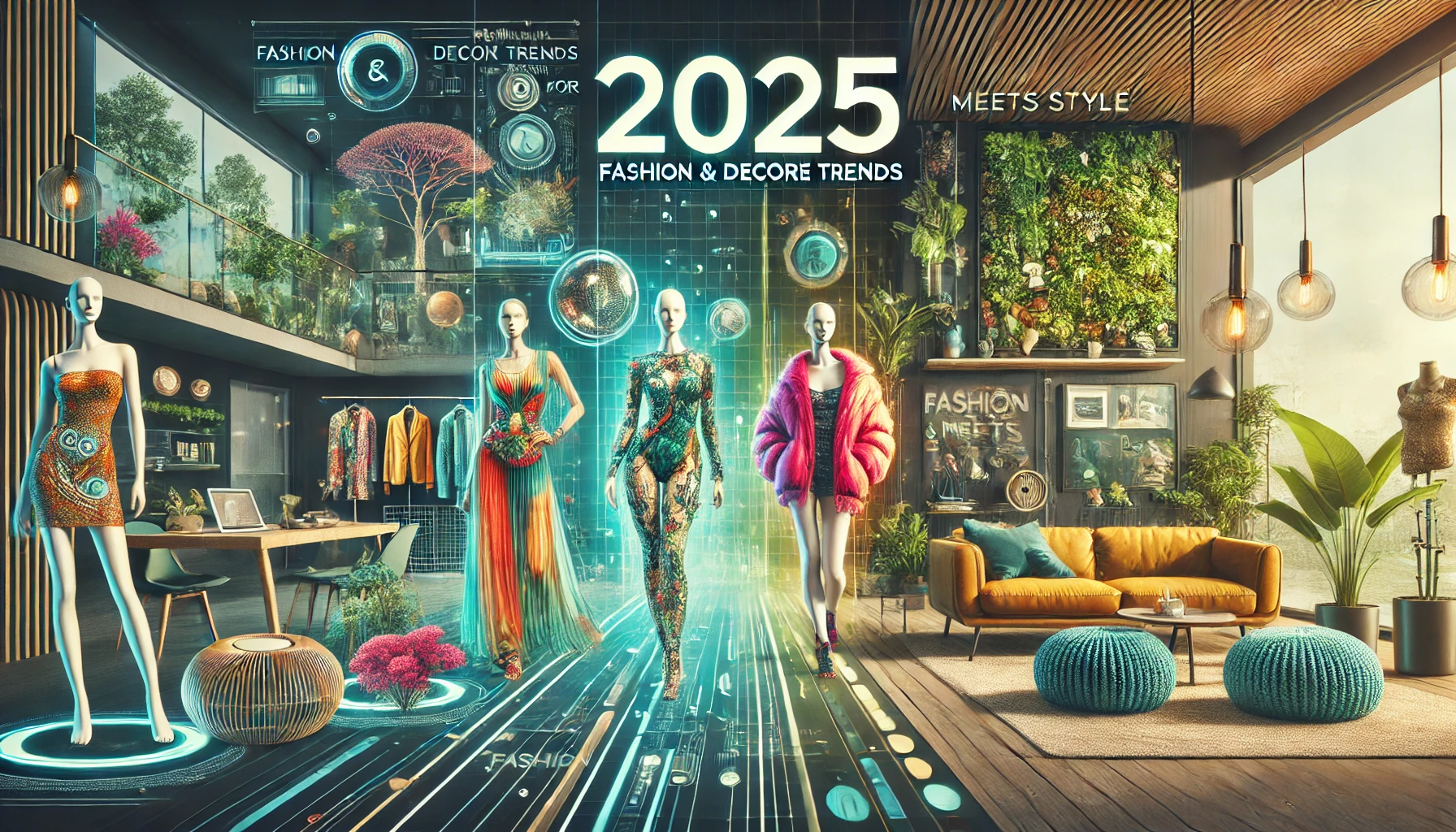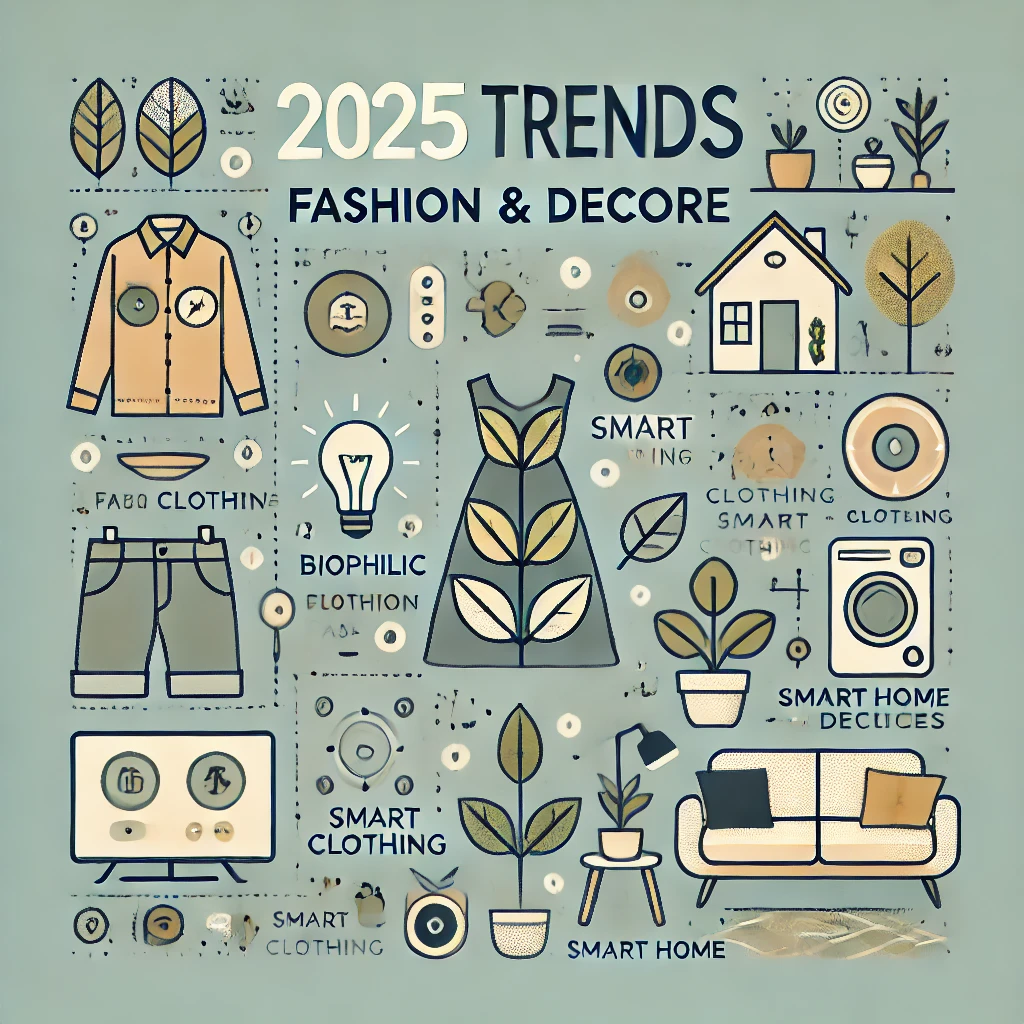The year 2025 is just around the corner, and the future of fashion and home décor promises a fascinating fusion of sustainability, technology, and personalization. With evolving consumer demands, emerging technologies, and a stronger focus on the environment, the upcoming trends in fashion and décor are poised to redefine how we dress, decorate and live.
In this blog, we’ll explore the key trends, themes, and innovations shaping the future of fashion and home décor in 2025.
1. The Rise of Sustainable Fashion and Décor
Fashion Goes Green
Sustainability is no longer a buzzword—it’s the backbone of the fashion industry. In 2025, brands will shift from fast fashion to circular fashion models that emphasize reuse, repair, and recycling. Consumers will favor clothes made from organic fabrics, recycled fibers, and plant-based materials like pineapple leather and mushroom fabrics.
Expect to see:
- Eco-friendly dyes: Non-toxic, water-conserving dyes for bold, vibrant colors.
- Repairable clothing: Built-in features that allow users to repair clothes instead of discarding them.
- Timeless designs: Minimalist and classic styles that reduce the need for constant wardrobe updates.
Sustainable Décor
In home décor, the focus will be on eco-friendly materials like reclaimed wood, recycled metals, and biodegradable paints. Expect homes to feature furniture made from bamboo, cork, and hemp, alongside energy-efficient lighting and appliances.
Highlights:
- Upcycled furniture: Unique pieces crafted from salvaged materials.
- Natural textures: Rattan, jute, and stone will bring organic warmth to interiors.
- Carbon-neutral designs: Décor brands will embrace carbon offsetting to reduce their environmental impact.
2. Technology-Driven Fashion and Décor
Fashion Meets Tech
In 2025, smart clothing will take center stage. Imagine outfits that adapt to temperature changes, track fitness data, or even charge your devices. AI-powered customizations will allow consumers to design and fit garments virtually before buying.
Innovations to watch:
- Wearable tech: Smart jackets that regulate body temperature or handbags with built-in charging ports.
- Digital wardrobes: Virtual try-ons and AI styling assistants to minimize returns and over-purchasing.
- 3D-printed clothing: Custom-fit garments created on-demand, reducing waste.
Smart Homes and Décor
Home décor will be revolutionized by AI and IoT (Internet of Things). Smart home devices will seamlessly integrate into interior design, offering both functionality and style.
Upcoming trends:
- Voice-controlled décor: Curtains, lighting, and temperature control managed through smart assistants.
- Augmented reality (AR): Tools that let homeowners visualize furniture placement and color schemes before purchase.
- AI furniture: Chairs that adjust their firmness or beds that track your sleep patterns.
3. Personalization is King
In 2025, personalization will dominate both fashion and décor as consumers seek items that reflect their unique identities.
Personalized Fashion
Brands will offer made-to-order garments, reducing overproduction and waste. AI and 3D body scanning will ensure a perfect fit for every individual. Custom embroidery, color palettes, and even fabric patterns will allow buyers to co-create their outfits.
Key trends:
- DIY fashion kits: Consumers can assemble their clothing, fostering creativity and sustainability.
- Gender-neutral designs: Unisex fashion will continue to grow, emphasizing inclusivity.
- Localized influences: Fashion inspired by regional cultures, tailored for global appeal.
Customized Décor
In home décor, the focus will shift to creating personalized spaces that tell a story. From bespoke furniture to custom lighting, homeowners will have more control over the look and feel of their interiors.
Expect to see:
- Modular furniture: Configurable designs that adapt to changing needs.
- Custom art installations: One-of-a-kind pieces that bring personality to spaces.
- Hybrid spaces: Multifunctional rooms that serve as offices, gyms, or relaxation zones.
4. Nature-Inspired Fashion and Décor
As the world grapples with climate change, a return to nature will influence design choices in 2025.
Biophilic Fashion
Fashion designers will draw inspiration from natural patterns, earthy tones, and sustainable practices. Expect leaf motifs, floral embroidery, and earthy color palettes like terracotta, moss green, and ocean blue.
Highlights:
- Nature-based prints: Patterns inspired by forests, oceans, and landscapes.
- Comfortable silhouettes: Relaxed fits and flowing fabrics that mimic the freedom of nature.
- Eco-luxury brands: High-end fashion houses embracing sustainability without compromising elegance.
Biophilic Décor
Biophilic design, which incorporates natural elements into interiors, will be a leading trend in home décor. Living walls, indoor gardens, and water features will make homes feel like sanctuaries.
Décor ideas:
- Green spaces indoors: Vertical gardens, potted plants, and indoor trees.
- Natural lighting: Skylights and large windows to maximize sunlight.
- Water elements: Fountains and aquariums for a calming effect.
5. Bold Colors and Patterns
The minimalism of the 2010s and 2020s will give way to bold, expressive designs in 2025. Both fashion and décor will embrace maximalism, celebrating creativity and individuality.
Fashion Gets Playful
Statement pieces, vibrant hues, and eclectic prints will dominate the fashion landscape. Think neon accents, color-blocked outfits, and psychedelic patterns that make a bold statement.
Key elements:
- Layered looks: Combining textures, prints, and patterns for a striking effect.
- Metallic finishes: Shiny, futuristic elements for a bold aesthetic.
- Statement accessories: Oversized bags, chunky jewelry, and flamboyant hats.
Vivid Décor
In home décor, walls and furniture will come alive with bold colors, geometric patterns, and artistic accents.
Ideas to explore:
- Accent walls: Bright, patterned wallpaper for a focal point.
- Colorful furniture: Sofas and chairs in bold shades like mustard yellow or deep teal.
- Artistic lighting: Sculptural lamps and chandeliers as statement pieces.
6. Ethical and Inclusive Design
Consumers in 2025 will prioritize brands that champion ethical practices and inclusivity.
Ethical Fashion
Sustainable sourcing, fair wages, and transparent supply chains will be non-negotiable for fashion brands. Labels will collaborate with local artisans, preserving traditional crafts while empowering communities.
Key themes:
- Slow fashion: Prioritizing quality over quantity to reduce environmental impact.
- Artisan collaborations: Handcrafted pieces with cultural significance.
- Inclusive sizing: Fashion that celebrates diversity in all forms.
Inclusive Décor
Home décor will embrace universal design principles, ensuring spaces are accessible to all.
Highlights:
- Ergonomic furniture: Designs that prioritize comfort and functionality.
- Adaptive lighting: Adjustable brightness and color temperature for different needs.
- Accessible layouts: Spaces designed with mobility and inclusivity in mind.
Conclusion: The Future is Bright
The future of fashion and home décor in 2025 is a celebration of innovation, sustainability, and individuality. As we embrace eco-friendly practices, integrate smart technologies, and prioritize personal expression, our wardrobes and homes will become more reflective of who we are and the world we want to live in.
From biophilic designs to smart fashion and bold aesthetics, the trends of 2025 promise a future where creativity meets responsibility. Whether you’re updating your wardrobe or redesigning your space, the possibilities are endless.
Discover the future of décor and fashion with VibiTude. Stay ahead o


